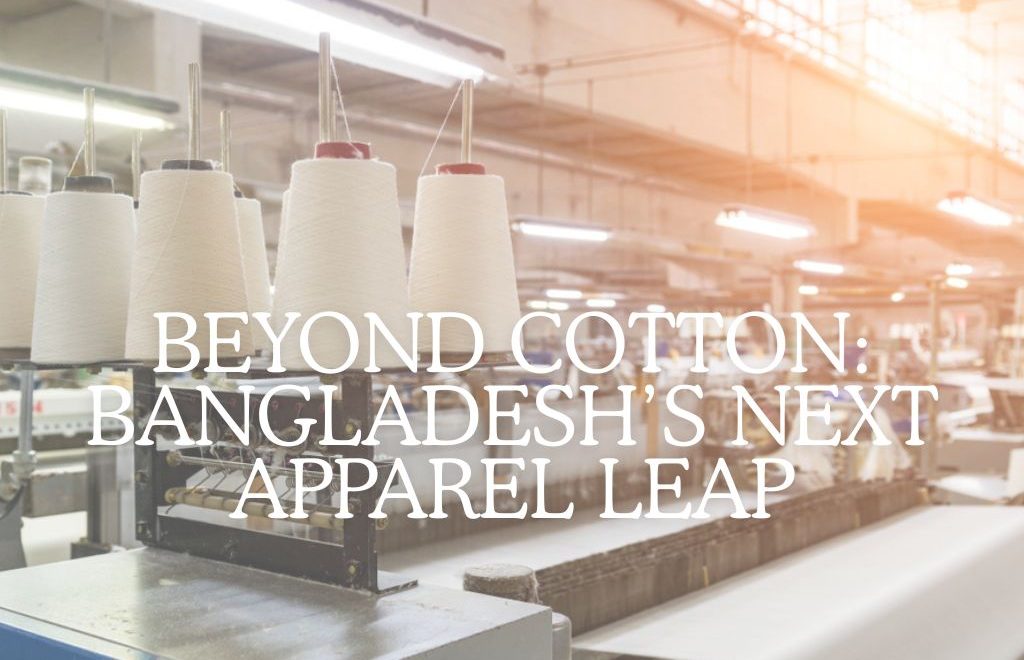Beyond Cotton: How Non-Traditional Segments Are Redefining Bangladesh’s Apparel & Footwear Industry
From Basics to Breakthroughs: Why Diversification Matters Now
For decades, Bangladesh has anchored its global apparel leadership on cost-effective, large-scale cotton-based production—particularly in basics like T-shirts, polos, and trousers. While this focus on price competitiveness powered an export boom, the ground beneath is shifting. Rising labor costs, mounting global sustainability demands, fast-changing consumer preferences, and increasing automation in rival sourcing countries are threatening the dominance of low-margin products. Diversification is no longer a luxury; it is a strategic imperative. By moving into man-made fibers (MMF), technical textiles, value-added categories, and non-leather footwear, Bangladesh can evolve from a volume player into a value-centric hub.
The Rise of Man-Made Fibers (MMF)
Globally, over 60% of garments are now made from synthetic or blended fibers. Bangladesh, historically skewed towards cotton, is rapidly catching up. MMF now comprises around 24% of total apparel exports and is projected to cross 30% by 2027. Several factors are catalyzing this growth: increasing global demand for performance wear, the rise of active lifestyles, and the necessity of moisture-wicking, quick-dry, and stretchable garments. Major manufacturers like Fakir Apparels, Square Textiles, and Viyellatex are investing in MMF dyeing units, circular knitting, and polyester-viscose fabric facilities.
Case in point: Fakir Apparels has recently launched a new production line dedicated entirely to spandex-polyester activewear, servicing brands in North America and Europe. The shift is also backed by a more resilient supply chain, including domestic MMF yarn producers and machinery import incentives.
Surge in Value-Added Apparel Segments
Denim is a bellwether of Bangladesh’s capability in value-added manufacturing. What began with basic five-pocket jeans has matured into a sector that now produces stretch, sustainable, laser-washed, and color-varied denims. The export value of denim alone crossed $1 billion in 2024, supported by investment in eco-finishing, ozone washes, and recycled fibers.
The lingerie and intimatewear segment is witnessing a silent revolution. Products such as seamless bras, shapewear, maternity intimates, and padded undergarments are increasingly being sourced from Bangladesh. Factories like Mondol Intimates and Hop Lun Bangladesh have transformed with specialized equipment like ultrasonic bonding, foam molding, and multi-needle machines.
Even more futuristic are smart textiles. While still in early stages, local universities and startups are developing textiles embedded with sensors to track body temperature, heart rate, and motion. Although production volumes remain limited, early partnerships with international brands and tech accelerators hint at a promising horizon.
Technical Textiles & Industrial Applications
The COVID-19 pandemic unexpectedly showcased Bangladesh’s capability to produce technical textiles, particularly PPE kits and medical-grade masks. This emergency response laid the groundwork for long-term investment in industrial and functional textiles. The government has identified geotextiles, agrotextiles, and meditech fabrics as priority areas.
Industries catering to construction, mining, and agriculture are showing strong demand for high-strength, performance-specific textiles. Bangladesh’s entry into uniforms and industrial workwear is also gaining ground, with companies like Protos Apparels and Unilliance contributing to exports in these niches. These B2B apparel categories offer stable year-round demand, unlike the season-driven fashion industry.
Footwear’s Non-Leather Boom
Footwear is the next frontier. Bangladesh exported over $1.1 billion worth of footwear in 2024, with 41% year-on-year growth largely driven by non-leather categories. EVA flip-flops, PU sneakers, mesh trainers, and kids’ shoes are dominating exports to Europe and Southeast Asia. Leading players like Apex, Bay Footwear, and Jennys Shoes are investing in CAD systems, robotic cutting, and injection molding to improve productivity and reduce lead times.
The country is attracting increasing attention from brands like H&M, Deichmann, and Primark, who are looking for ethical, cost-efficient alternatives to traditional hubs like China and Vietnam. While Vietnam leads in terms of technical sophistication and design, Bangladesh is quickly closing the gap, especially in sportswear and casual footwear.
Investment Shifts in Manufacturing
The evolution into non-traditional segments is also reshaping production infrastructure. Factory layouts are being reconfigured to accommodate modular lines, smaller batch production, and machine-intensive processes. Technologies such as 3D knitting, digital printing, automatic sewing, and laser cutting are being adopted to meet the precision demands of technical and high-end fashion products.
Workforce transformation is equally critical. Upskilling sewing machine operators, line supervisors, and quality controllers to work with new materials and machines is ongoing. Brands are increasingly co-investing in these skill-building initiatives, and several factories are partnering with local training institutes and international consultants to stay competitive.
Capital expenditure (CAPEX) trends reveal that more factories are prioritizing MMF-specific machinery, cleanroom environments for PPE production, and green certifications to meet buyer demands for sustainability and compliance.
Policy Support & Challenges
The government has begun offering 4% export incentives on MMF apparel and up to 10% on technical textiles. Additionally, import duties have been relaxed for MMF raw materials, and specialized zones are being considered for these sectors. Yet, the pace of infrastructure development, high logistics costs, and a lack of centralized R&D facilities remain major hurdles.
Bangladesh’s imminent graduation from LDC status in 2026 will phase out preferential market access under schemes like the EU’s EBA (Everything But Arms). This further elevates the need to build competitiveness through innovation, product diversification, and sustainable practices. Rapid implementation of the National Industrial Policy 2022 and Textile Policy 2024 will be key to closing these gaps.
Strategic Roadmap for Manufacturers
Mid-sized factories must embrace the shift toward product and process specialization. Rather than trying to serve all categories, manufacturers should identify 1-2 niche product segments aligned with their capabilities and invest accordingly. This may include exploring categories like:
– Compression garments for medical and sports applications
– Nursing bras and shapewear in intimate wear
– Eco sneakers and recyclable sandals in footwear
– Industrial safety clothing in technical textiles
Consulting firms can play a key role in facilitating this transition through diagnostic assessments, lean implementation, design capability building, and market linkage strategies. International buyers are increasingly looking to collaborate with suppliers who demonstrate not just low cost but product uniqueness, consistency, and speed.
Export Identity 2.0
Bangladesh is on the cusp of a major transformation in its apparel and footwear industry. From a low-cost basics supplier to a diversified, value-added, and tech-enabled sourcing destination, the country is rewriting its export identity.
To fully realize this potential, stakeholders across the value chain—manufacturers, policymakers, training institutions, and buyers—must work in sync. The future of Bangladesh’s RMG sector lies not in price wars but in innovation, agility, and differentiation. In the race beyond cotton, Bangladesh is no longer just a participant; it is a strong contender.
The next chapter in Bangladesh’s apparel journey is being written in man-made fibers, molded soles, bonded seams, and embedded circuits.
It’s time the world took note.

Divya Mohan
General Manager (International Business)
divyamohan@groyyo.com


Leave a Comment